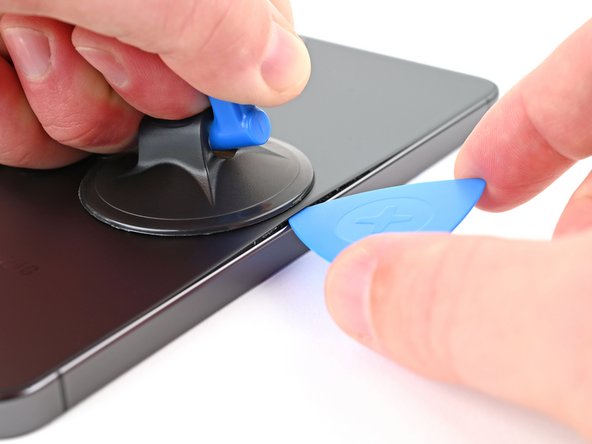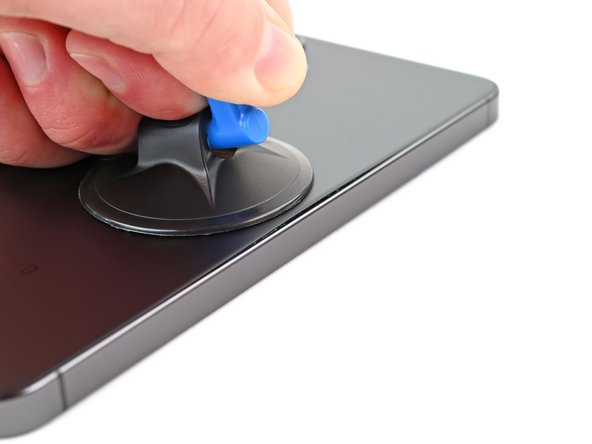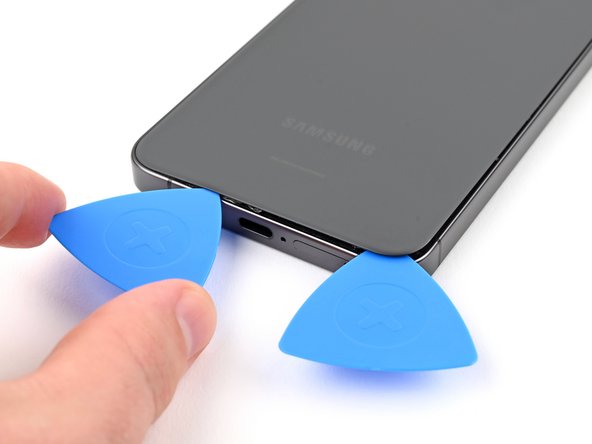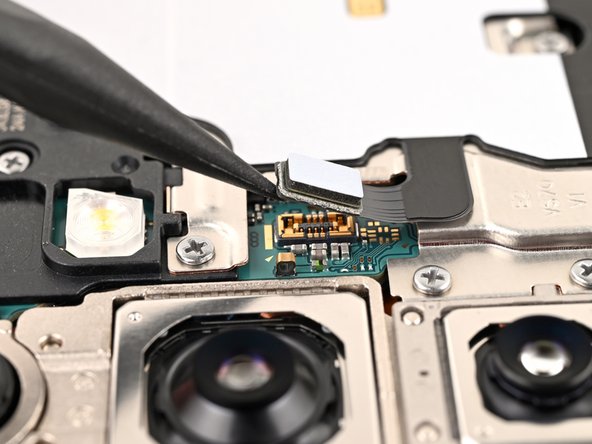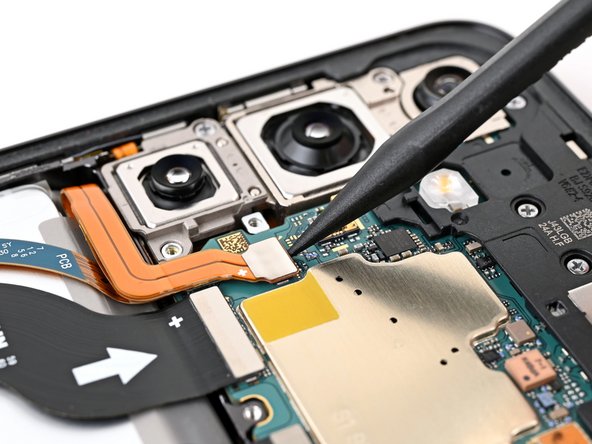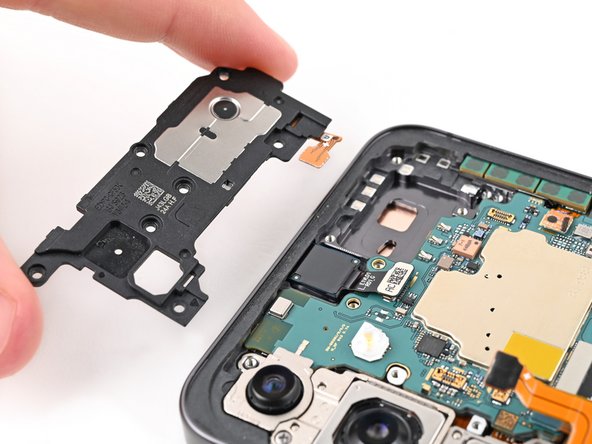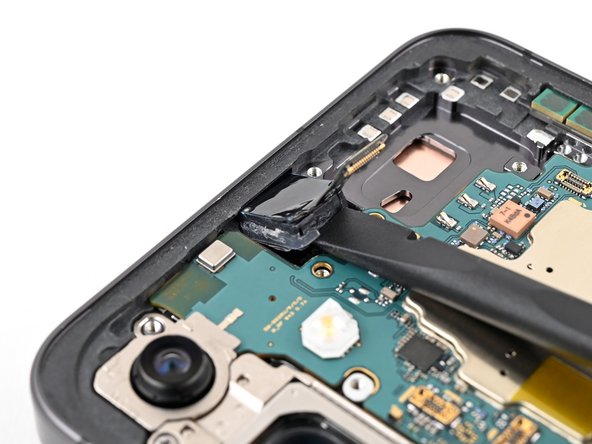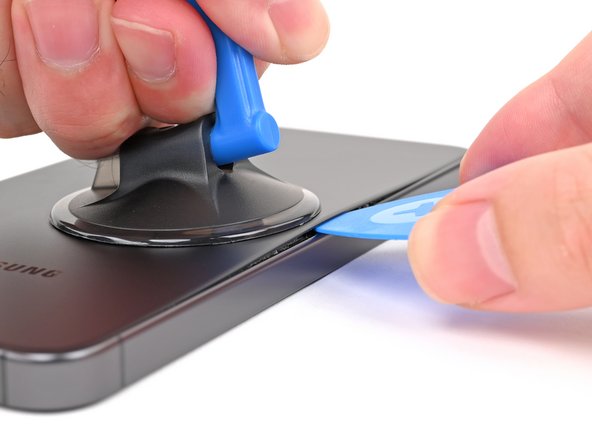Samsung Galaxy S24+ Front Camera Replacement Guide: Step-by-Step DIY
Duration: 45 minutes
Steps: 27 Steps
Ready to give your Samsung Galaxy S24+ a fresh set of eyes? Let’s swap out that front camera and get you snapping selfies like a pro! This guide will walk you through the process step-by-step, so don’t worry, it’s a piece of cake. If you need help, you can always schedule a repair.
Step 1
Let’s get that battery down to 25% or less, just to be safe. We wouldn’t want to deal with any surprises with a charged lithium-ion battery! If your battery is looking a little swollen, no worries – just be extra careful, and if you need help, you can always schedule a repair.
– Let’s get this phone powered down! Unplug all those cables and then hold down the side key and volume down button. Next, tap ‘Power off’ to give your phone a little break.
Step 2
When using heat to loosen things up, remember that a hair dryer, heat gun, or hot plate can be super helpful – just be gentle and don’t overdo it. Your phone’s display and internal battery are sensitive to heat, so keep an eye on things. If you need help, you can always schedule a repair
– Warm up an iOpener and gently place it on the right edge of the back cover for a cozy two-minute hug.
Tools Used
Step 3
Having trouble getting that gap started? No worries, just apply a bit more heat to loosen up the adhesive. Be sure to follow the iOpener instructions to avoid overheating. And if you need help, you can always schedule a repair
– First, attach a suction handle to the back cover, positioning it as close to the center of the right edge as you can.
– Next, give the suction handle a firm, steady pull to create a gap between the cover and the frame – you got this!
– Now, take an opening pick and carefully insert it into the gap you just created. If you need help, you can always schedule a repair
Tools Used
Step 5
– Let’s get this repair started! Apply a heated iOpener to the bottom edge of the back cover for about two minutes. If you need help, you can always schedule a repair
Tools Used
Step 6
– Alright, let’s get this party started! Carefully slide that opening pick around the bottom right corner to loosen up that sticky situation. Think of it like a dance, but with tools. We’re going to get this phone back in tip-top shape!
Step 7
– Alright, let’s get this party started! Slide a second pick into the bottom right corner. We’re getting that adhesive loosened up!
– Now, with your trusty opening pick, slide it along the bottom edge from right to left. We’re separating that adhesive like a pro!
– Hold onto that pick at the bottom left corner. We don’t want that adhesive sneaking back together! Stay tuned, we’re almost there!
Step 8
– Let’s warm things up! Apply a heated iOpener to the left edge of the back cover for two minutes. It’s like giving your device a little hug with heat!
Tools Used
Step 9
– Gently twist the opening pick around the bottom left corner to break free the adhesive. Keep it smooth and steady!
Step 10
– Slide a third opening pick into the bottom left corner like a pro.
– Gently glide that pick up toward the top left corner to break free from the adhesive’s grip.
– Keep the pick resting near the top left corner to ensure the adhesive doesn’t get any funny ideas about sticking back together.
Step 11
– Heat things up a bit by using an iOpener on the top edge of the back cover for about two minutes. You’re doing great!
Tools Used
Step 12
– Let’s get this party started! Give that top left corner a little love with your opening pick. Gently rotate it around to loosen up that adhesive. You’re doing great!
Step 13
– Alright, let’s get this party started! Insert your fourth opening pick at the top left corner. We’re about to loosen things up a bit.
– Slide that pick towards the top right corner, just like you’re sliding into home plate! This will separate the adhesive holding everything together.
– Leave the pick near the top right corner, to keep that adhesive from getting any funny ideas about sticking back together. We don’t want any surprises, right?
Step 14
Notice the square of adhesive surrounding the rear microphone, conveniently located just above the flash. If you need help, you can always schedule a repair
– Align the tip of your trusty opening pick with the flash.
– Gently slide that pick beneath the top edge of the back cover until you feel it catch on the adhesive.
– Continue to glide the pick towards the bottom of the phone while gently lifting the cover, freeing it from the adhesive as you go. You’ve got this!
Step 15
If the back cover is giving you a hard time, grab an opening pick to help break any adhesive that’s holding it down.
Now’s a great time to power up your phone and check that everything’s working like a charm before you seal it back up. Just remember to turn it off completely before diving back into the repair!
Keeping that water resistance intact after your repair will hinge on how well you reapply the back cover adhesive, but heads up—your device will lose its IP (Ingress Protection) rating.
– Let’s get this party started! First things first, grab that back cover and give it a gentle tug to remove it. It’s like saying goodbye to an old friend, but in a good way.
– Alright, now we’re getting into the nitty gritty. When you put it all back together, remember these tips:
– Use tweezers or your fingers to remove any adhesive from the back cover and the phone. It’s like cleaning up after a great party – just make sure you get all the remnants of that sticky stuff.
– If those adhesives are being stubborn, don’t panic! Grab some heat or isopropyl alcohol (90% or greater) and a coffee filter or lint-free cloth. Gently warm up the adhesive and it’ll come right off. It’s like giving it a little spa treatment.
– Using custom-cut adhesives? No sweat! Just follow this guide. You got this!
Tools Used
Step 16
Look for a little arrow near each press connector. That’s your friendly prying guide! It shows you the best spot to get started.
– Grab your trusty spudger and gently pry up the wireless charging coil press connector from the motherboard. You’re like a surgeon with a tiny tool, disconnecting those electrical pathways with precision!
– Time to reconnect! Carefully line up the connector over its socket, and then give it a little nudge with your fingertip. First one side, then the other, until you hear that satisfying click. Don’t force it! If things aren’t lining up, just reposition it and try again. You’re a pro, and you’ve got this! If you need help, you can always schedule a repair
Tools Used
Step 17
– Grab your trusty Phillips screwdriver and let’s tackle those thirteen 3.5 mm-long screws holding down the wireless charging coil and the loudspeaker:
– First up, there are six screws keeping the wireless charging coil snug and secure.
– Next, you’ll find seven screws that are holding the loudspeaker in place.
Step 19
– Let’s get those speakers out! Use your fingers to gently lift the loudspeaker away from the frame. No need to be rough! It’s like giving the loudspeaker a little high five.
– Now that the loudspeaker is free, remove the wireless charging coil. It’s like taking a break from the game – just temporarily. The loudspeaker will be back in action in a flash.
– Time to put it all back together! Press around the edges of the loudspeaker to clip it to the frame before reinserting the screws. It’s like giving it a warm hug before you say goodbye.
Step 21
– Alright, grab your trusty spudger and let’s give that earpiece speaker press connector a little nudge! Gently pry it up and disconnect it. It’s like giving your phone a little break from the music. You got this! If you need help, you can always schedule a repair.
Tools Used
Step 22
– Grab your trusty Phillips screwdriver and pop out the five 3.5mm-long screws holding down the earpiece speaker. If you need help, you can always schedule a repair.
Step 23
– Slide the flat end of a spudger between the bottom edge of the earpiece speaker and the metal plate on the motherboard.
– Twist the spudger to unclip the earpiece speaker from the frame and pop it out.
– When putting it back together, insert the top edge of the earpiece speaker into the frame first before pressing down and snapping it back in.
Tools Used
Step 24
– Time to get started with your repair. Use a spudger to carefully pry up and disconnect the front camera press connector. If you need help, you can always schedule a repair
Tools Used
Step 25
– Grab a hair dryer or a heat gun and give that front camera some love by warming it up until it’s nice and toasty to the touch.
Tools Used
Step 26
The adhesive holding that camera in place is super sticky! Take your time, and if it feels like it’s not budging, just add a little more heat. Remember, keep the sensor and lens together—no need to separate them like they’re in a bad breakup!
If the camera is feeling a little stubborn and doesn’t want to budge, don’t fret! Grab your handy-dandy SIM card eject tool and carefully scrape away the adhesive around the camera. It’s like giving it a little nudge to loosen up! If you need help, you can always schedule a repair.
– Time to get that front camera out – use the flat end of a spudger to carefully pry it from its frame recess. If you need help, you can always schedule a repair
Tools Used
Step 27
– Grab a spudger and carefully pry the front camera out of its spot until you can hold it with your fingers.
– Take out the front camera.
Tools Used






